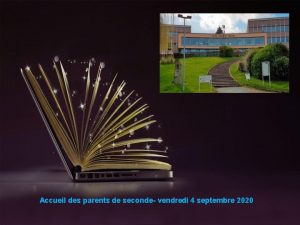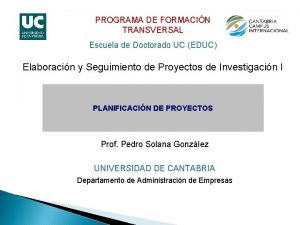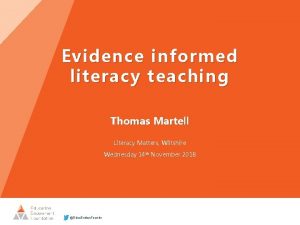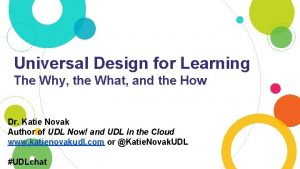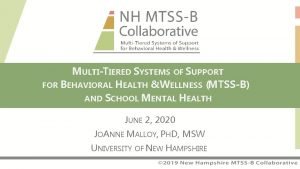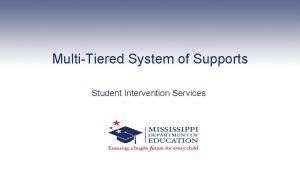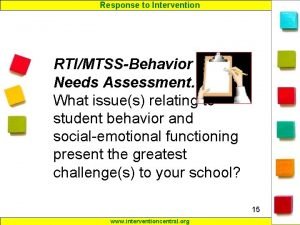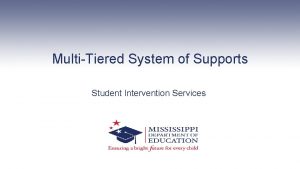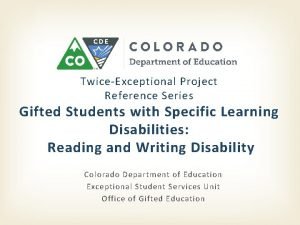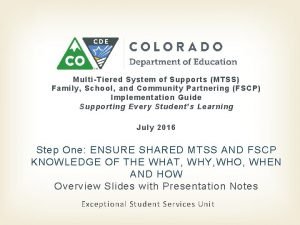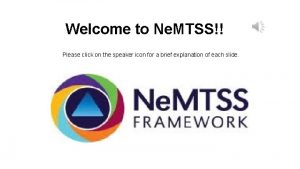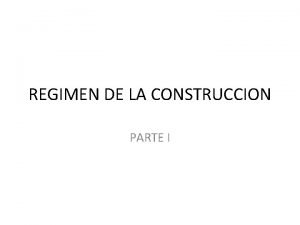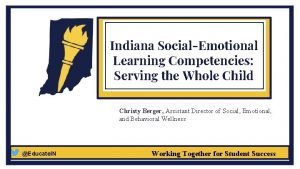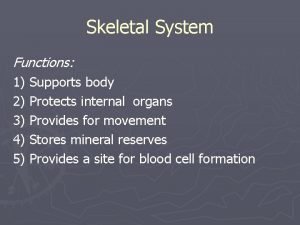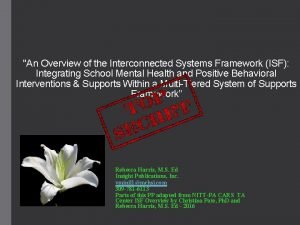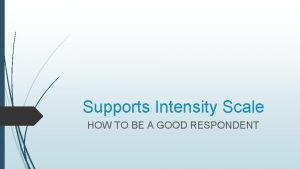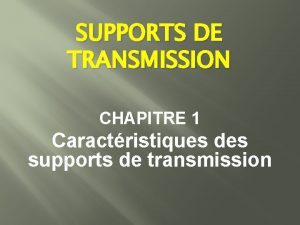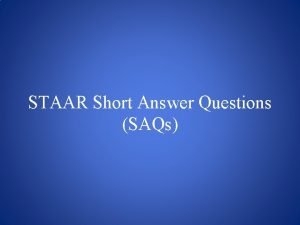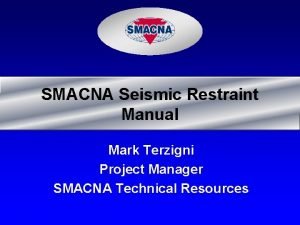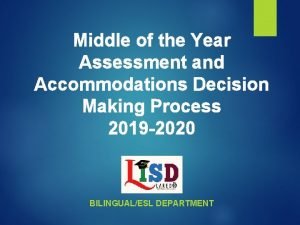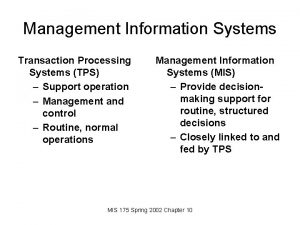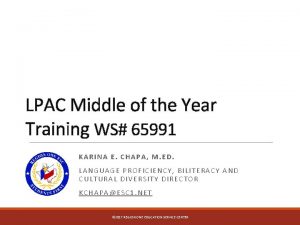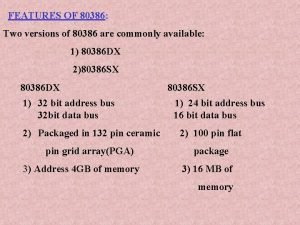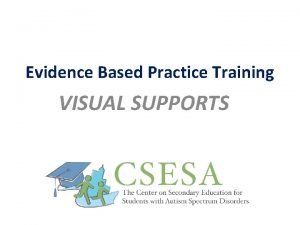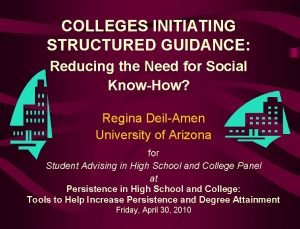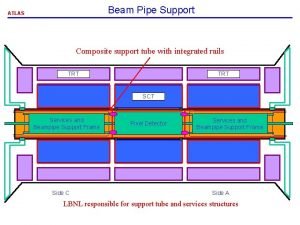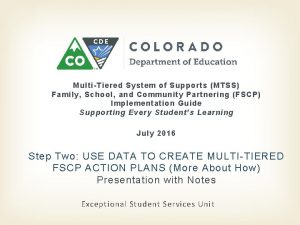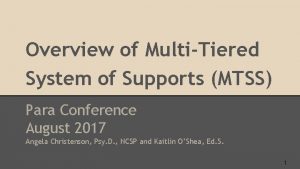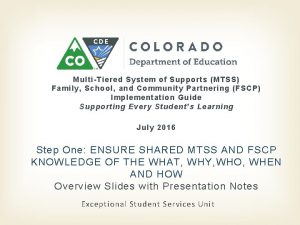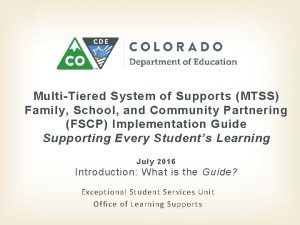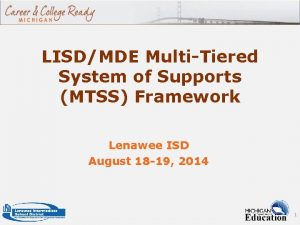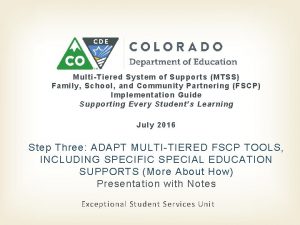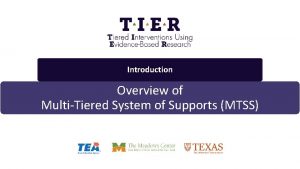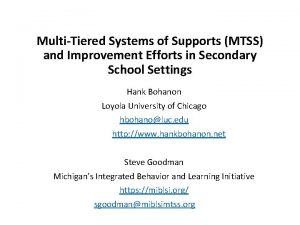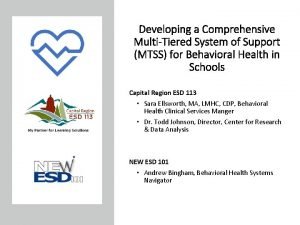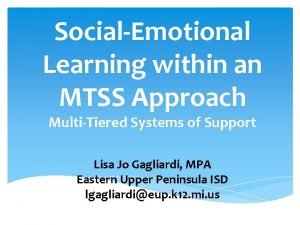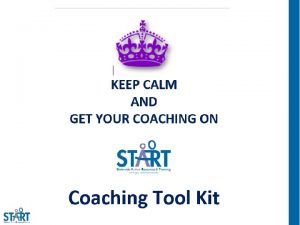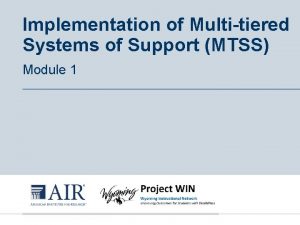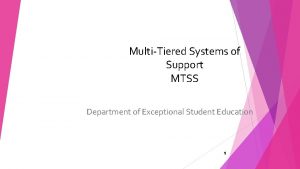MultiTiered System of Supports MTSS Summer 2018 EDUC
































- Slides: 32

Multi-Tiered System of Supports (MTSS) Summer (2018) EDUC 5545 John J. Hoover, Ph. D. University of Colorado Boulder 2018 John J. Hoover

Topical Areas Addressed In this Presentation • • • What is an effective MTSS program? How is MTSS different from previous models? What are general educator responsibilities in MTSS? What are key features of MTSS for Els? What are a few select instructional best practices within MTSS? 2018 John J. Hoover

Where we have been and Where we are today 1980 s-Response to Treatment (RTT) 1990 s-Response to Instruction (RTI) 2000 s-Response to Intervention (RTI) 2010 s-Response to Instruction and Intervention (RTI 2) Present-Multi-tiered System of Support (MTSS) 2018 John J. Hoover

A Multi-Tiered System of Support What is an effective MTSS Framework? 2018 John J. Hoover

Multi-Tiered System of Support A Multi-Tier System of Supports (MTSS) is a contemporary framework that enables schools to establish structures and practices for providing all learners with the supports they need to succeed in the classroom (Hoover & Soltero-Gonzalez, 2018) MTSS incorporates both response to intervention (RTI) and positive behavior intervention and supports (PBIS) 2018 John J. Hoover

MTSS Goal School use of resources to enable every child to be successful, accomplished by: • Being prevention oriented: knowing who needs support as early as possible each year and putting those supports in place • Implementing evidence-based interventions for all students and tailoring interventions based on student needs • Using progress monitoring data to know when to make a change in instruction 2018 John J. Hoover

Colorado Department of Education (CDE) Adopts MTSS Combines Elements of RTI and PBIS into one system: 1. Shared Leadership to support collaborative input and decision-making 2. Data-Based to frame instructional, referral, and placement decision-making 3. Multi-Tiered Continuum to deliver layered, timely instruction that increases in intensity and duration as struggles become evident 4. Evidence-Based Practice grounding instruction, assessment, and decision-making 5. Universal Screening and Monitoring designed to measure growth and progress of learners who are struggling on a more frequent basis (e. g. , weekly, monthly, etc. ) 6. Family, School, Community Engagement to create collaborative MTSS with families, educators, and community members Source: Hoover & Teeters (in press). 2018 John J. Hoover

Two Concerns Contributed to Rise of MTSS • Concern 1—The increase in the number of students placed in special education for a reading or language learning disability, particularly ELs • Concern 2—The questionable validity of using special education assessment process for identifying needs, especially IQ achievement discrepancy for determining a learning disability 2018 John J. Hoover

MTSS Features • Multi-tiered, problem • -solving approach that addresses academic (RTI) and behavioral needs of students (PBIS) It is an integrated school model that is often standardsdriven and attempts to incorporate both prevention and intervention 2018 John J. Hoover

MTSS/Three-Tiered Instruction Supplemental assistance, as part of general education support system 15 -20% 3 rd Tier Intensive/ Spec Ed 1 -5% 2 nd Tier 1 st Tier 2018 John J. Hoover Research-based instruction in general education Classroom 80 -85%

What facilitates School-Wide MTSS Success? Integrated use of RBC, EBI, DI MTSS is Total Education in School Administrative /MTSS Team Support Clearly Defined Data Based Decision-Making MTSS Success Factors 2018 John J. Hoover Aligned Tier 1 and 2 Instruction and Assessment with Fidelity

MTSS Models How MTSS differs from previous models? 2018 John J. Hoover

Transitioning from Prereferral to MTSS Models MTSS requires change in how we view teaching and learning 2018 John J. Hoover

MTSS - Prereferral Comparison MTSS Framework Prereferral Model Grounded in Gen. Ed. Cur. Grounded in Intrinsic Disorders Screen all learners Screening not completed for all Evidence-based practice RBC/EBI not required Achievement discrepancy Learning Potential discrepancy Progress monitoring CBM assessment Infrequent monitoring Norm referenced assessment Prevention Quality of instruction Wait to Fail Intrinsic learner problems 2018 John J. Hoover

Viewing Learners who Struggle within MTSS Overarching curriculum decision-making implication: How we think about the interaction between curriculum implementation and progress of struggling learners 2018 John J. Hoover

Viewing Learners who Struggle within MTSS Lack of progress is viewed from a new perspective in MTSS: 1. In what ways are learners’ struggles related to how the curriculum is being implemented? 2. In what ways are learners’ struggles related to expectations about the curriculum being implemented? 3. How might we adjust the curriculum implementation to improve student progress? 2018 John J. Hoover

Know your Curriculum!!! All classroom teachers must possess working knowledge of the: Purposes Validity Processes associated with implementing curriculum within MTSS 2018 John J. Hoover

Curriculum Effectiveness = MTSS Success Underlying Premise: “Successful school-wide MTSS models are grounded in the implementation of the daily curriculum with fidelity” 2018 John J. Hoover

Evidence-Based Practice Research-based curriculum (RBC): Comprehensive General Education Curriculum Evidence-based interventions (EBI): Structured interventions to support implementation of RBC and EBI work together to deliver effective curriculum in MTSS 2018 John J. Hoover

Evidence-Based Practice: Teaching Matters: Explicit Instruction (video) http: //www. youtube. com/ watch? v=APyvw. Pzx. Z 7 I Discuss how your instruction incorporates the framework in the video when teaching: 1 -students with disabilities 2 -students who struggle 3 -ELs 2018 John J. Hoover

MTSS Models Educator roles in MTSS 2018 John J. Hoover

Educator Responsibilities Know the Functions of Each MTSS Tier 1 - Research-based Core curriculum provided to all learners Tier 2 – Supplemental instruction provided to struggling learners, aligned with and in addition to Tier 1 Tier 3 – Intensive interventions and/or curricula provided to students with significant educational needs, including students with disabilities 2018 John J. Hoover

Educator Responsibilities General Education Classroom Teachers 1. Implement Tier 1 instruction with fidelity 2. Progress monitor/Chart results 3. Differentiate/Adjust instruction appropriately 4. Confirm fidelity of Tier 1 instruction 5. Assist to align Tiers 1 and 2 Instruction 2018 John J. Hoover

Educator Responsibilities Selecting Appropriate Intervention Learner Expectations Typically Found in Curriculum and Assessment Development in Today’s schools A___________B___________C Language/Background Delivery Assessment A-Expectation that learner possesses needed language skills/background B-Expectation that student best learns the way curriculum is delivered C-Expectation that student best demonstrates progress the way it is assessed QUESTIONS: Do all students meet these expectations? If not, how is instruction adjusted? If not, how are curriculum-based measurements adjusted? 2018 John J. Hoover

Educator Responsibilities Effective Multi-Level instruction Maintains Instructional and Assessment Fidelity Practitioners must confirm that implementation fidelity exists to ensure that appropriate instruction occurs 2018 John J. Hoover

Effects of Lack of Fidelity? If curriculum implementation lacks fidelity then Progress scores are questionable leading to Unnecessary/inappropriate adjustments often contributing to Mistakenly believing that lack of progress is indicative of a disability 2018 John J. Hoover

Confirming Fidelity of Instructional Implementation is Essential in MTSS Ways to Confirm Fidelity Direct Confirmation: Observations Peer Co-Teaching In-Class Coaching Indirect Confirmation: Self-Reporting Interviews 2018 John J. Hoover

Educator Responsibilities Underlying MTSS Decision-Making Assumption MTSS presumes that if a child does not make adequate progress with research-based interventions, he/she may have an internal deficit (e. g. , learning disability) (Klingner & Bianco, 2006) * * * * However, to assume an internal deficit, instruction must be responsive and appropriate to student needs AND BE DELIVERED IN A WAY THAT AVOIDS MISINTERPRETING LEARNING DIFFERENCES/LANGUAGE ACQUISITION AS LEARNING, LANGUAGE OR BEHAVIORAL DISORDERS 2018 John J. Hoover

MTSS Models MTSS Effectiveness with ELs? 2018 John J. Hoover

What Makes MTSS Culturally and Linguistically Responsive? 4 Major Themes Cultural Context - Contextualize learning by building on and valuing students’ cultural values and norms in curriculum implementation Linguistic Context - Developing linguistic competence through functional, purposeful classroom dialogue Accommodations - Differentiate instruction to reflect communication styles and diverse community practices into the curriculum Cognitively Challenging - Emphasizes higher order thinking in teaching and learning (Hoover & Soltero-Gonzalez, 2018) 2018 John J. Hoover

MTSS Represents New Opportunities for CLD Learners with and without Disabilities 1. Improves opportunities through culturally and linguistically responsive education (Klingner & Edwards, 2006) 2. Reduces biased Instructional and diagnostic decisionmaking (Hoover & Klingner, 2011) 3. Assists in clarifying Difference/Acquisition from Disability (Hoover, Baca, & Klingner, 2016) 4. Reduces disproportionate representation in special education of CLD learners (Hoover & de. Bettencourt, 2017) 2018 John J. Hoover

Implementation of Best Practice Select Interventions Effective in MTSS • • • 1 Reciprocal Teaching (Reading) 2. Cognitive guided instruction (CGI) (Math) 3. Self-regulated learning (Writing) 4. Classwide Peer Tutoring (Reading/Math) 5. Peer assisted learning strategies (PALS) (Reading/Math) 6. Fernald multisensory approach (Reading) 7. Collaborative Strategic Reading (CSR) 8. Focus correction areas writing strategy (Writing) 9. Peer Revising Strategy (Writing) (J. J. Hoover, Linking Assessment with Instruction (2012) 2018 John J. Hoover
 Https nero l educdenormandie fr
Https nero l educdenormandie fr Cgt educ versailles
Cgt educ versailles Diagrama adm
Diagrama adm @educ
@educ Sfu educ 311
Sfu educ 311 Mtss and udl
Mtss and udl Mtss memes
Mtss memes Mtss-b
Mtss-b Mde mtss documentation packet
Mde mtss documentation packet Mtss needs assessment
Mtss needs assessment Mtss documentation packet
Mtss documentation packet Benefits of mtss
Benefits of mtss Mtss
Mtss Mtss nebraska
Mtss nebraska Decreto 283/996
Decreto 283/996 Mtss infographic
Mtss infographic Https://moodler.doe.in.gov/
Https://moodler.doe.in.gov/ Que letra continua m v t m j
Que letra continua m v t m j Bccie summer conference 2018
Bccie summer conference 2018 Which system supports the body
Which system supports the body Pros and cons of pbis
Pros and cons of pbis Supports intensity scale rating key
Supports intensity scale rating key Les supports de transmission
Les supports de transmission This excerpt supports the idea that rainsford has
This excerpt supports the idea that rainsford has Osi network management model
Osi network management model Smacna hangers and supports
Smacna hangers and supports Oral administration staar 2020
Oral administration staar 2020 Transaction processing system characteristics
Transaction processing system characteristics What are content and language supports
What are content and language supports Features of 80386
Features of 80386 Visual supports evidence based practice
Visual supports evidence based practice Structured guidance and supports
Structured guidance and supports Composite pipe supports
Composite pipe supports
